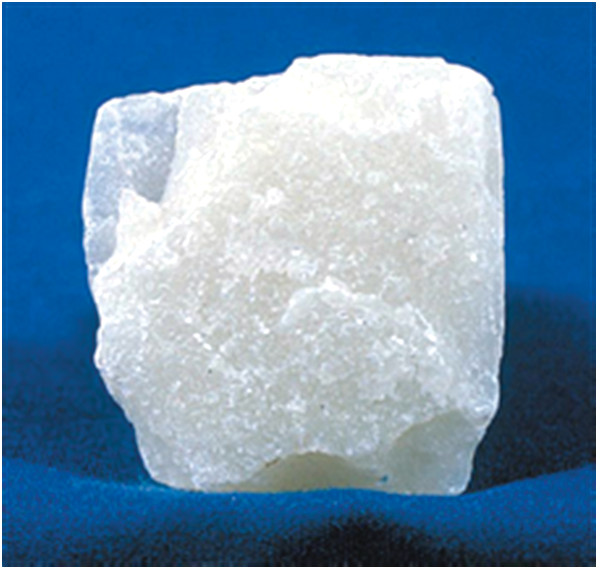
by U.S. Geological Survey Wednesday, January 28, 2015
Talc, a mineral mined in more than 40 countries, is distributed and used worldwide. Robert Virta, talc commodity specialist, and Brad Van Gosen, talc resource specialist, for the U.S. Geological Survey, prepared the following information about the talc industry.

Talc can be white, apple green, dark green or brown, depending on its composition. Credit: USGS; right: Mineral Information Institute.
When people think of talc, they often think of talcum and baby powder. However, these uses of talc are minor compared to its use in industrial manufacturing. The leading use of talc in the United States is in the production of ceramics, where it is a source of magnesium oxide, serves as a flux to reduce firing temperatures, and improves thermal shock characteristics of the final product. Worldwide, the major use of talc is as a paper constituent, where it fills the interstices between cellulose paper fibers, reduces paper transparency, improves ink receptivity, and absorbs undesirable tree sap residues that can generate blemishes in the paper.
Talc is a hydrous silicate composed of magnesium, silica (silicon and oxygen) and water that is relatively pure in composition but can contain small amounts of aluminum, iron, manganese and titanium. The physical and chemical properties that make talc commercially useful include chemical inertness, fragrance retention, high dielectric strength, high thermal conductivity, low electrical conductivity, luster, moisture content, oil and grease adsorption, purity, softness and whiteness.
In addition to ceramic and paper applications, talc is used to manufacture cosmetics, paint, plastics, roofing, rubber and a variety of other products. Some specific products that contain talc include the ceramic substrate of automobile catalytic converters, wire and cable insulation, auto body putty, asphalt shingles, window caulk, wallboard joint compound, pharmaceutical tablets, chewing gum, candy, gaskets, hoses, vinyl flooring and siding and, of course, baby and body powders. Talc also is used in agricultural applications as a chemical carrier for herbicides and pesticides and as a fruit-dusting agent.
For more information on talc and other mineral resources, visit http://minerals.usgs.gov/minerals.
In 2012, the United States produced 515,000 metric tons of talc valued at $17 million, with Montana leading production, followed by Texas, Vermont and Virginia.
World production of crude talc ore in 2012 was estimated at about 7.4 million metric tons.
China was the leading global talc producer (2.2 million metric tons), followed by India, the United States, Finland and France.
U.S. markets for talc, excluding imports, were ceramics (25 percent), paper (22 percent), paint (19 percent), roofing (9 percent), plastics (8 percent), cosmetics and rubber (3 percent each) and other (11 percent). Global markets for talc were paper (34 percent), plastics (23 percent), ceramics (15 percent), paint (12 percent) and other (16 percent).
The word “talc” likely derived from the Arabic word for mica, “talk,” acknowledging the mineral’s mica-like flakes.
Talc was used by the ancient Egyptians to carve scarabs and amulets; by the Assyrians to make cylinder seals and signets; and by Native Americans to form bowls, pots, cooking stoves and other utensils.
Talc is one of the oldest and most widely used cosmetic ingredients, dating to Egyptian times.
The white coating on some chewing gum and candy products is talc, which prevents it from sticking to the wrapper.
© 2008-2021. All rights reserved. Any copying, redistribution or retransmission of any of the contents of this service without the expressed written permission of the American Geosciences Institute is expressly prohibited. Click here for all copyright requests.